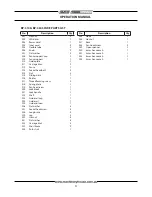
22
OPERATION MANUAL
Symptom
Possible Cause
Possible Solution
Machine slows
when operat-
ing
1. Applying too much pressure to workpiece.
2. Blade is dull.
1. Feed workpiece slower and in a smooth
motion
2.. Replace blade
Ticking sound
when the saw
is running.
1. Blade weld contacting support bearing.
2. Blade weld may be failing
1. Use file or stone to smooth and round the
back of the blade.
2. Inspect and replace blade if necessary
Blade touching
table insert.
1. Excessive side pressure when cutting.
2. Table improperly adjusted
1. Reduce side pressure.
2. Adjust table
Vibration when
cutting.
1. Loose or damaged blade.
1. Tighten or replace blade
Burn marks on
the edge of the
cut.
1. Too much side pressure when feeding
workpiece.
2. Blade too wide for size of radius being cut
1. Feed workpiece straight into the blade.
2. Install a smaller width blade/increase blade
tension.
Rough or poor
quality cuts.
1. Blade lead.
1. Blade lead is commonly caused by too fast
feed rate, a dull blade, or improper tension
6.2 WHEEL ALIGNMENT
Wheel alignment is one of the most important issues to
ensure the best performance from your band saw. Over
time vibration, and wandering blades cause tyre wear.
This can be considerably reduced when the wheels are
properly aligned. The procedure is as follows.
1. Remove the fence and table, then open both the
wheel covers.
2. Make sure the guide blocks and rear support
bearings have been moved away from the blade,
then tighten your blade to the tension that it will
be used during operation.
4. Place the straight edges against both wheels in
the positions shown in Fig. 6.1
5. The hub on the bottom wheel allows you to adjust
the lower wheel to be adjusted in the desired
direction. Turning all the bolts clockwise in equal
amounts pushes the wheel forward. Turning all
the bolts counter clockwise moves the wheel
towards the back of the machine. When the
screws are used individually, each bolt controls the
direction that the wheel tilts. (Fig. 6.2)
Fig. 6.1
Fig. 6.2













































